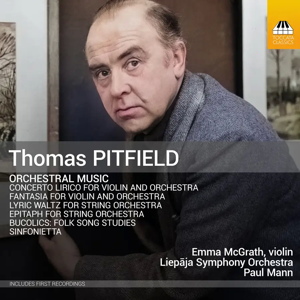
Thomas Pitfield (1903-1999)
Orchestral Music
Sinfonietta (1946)
Fantasia on an Old Staffordshire Tune, for violin and orchestra (1950)
Lyric Waltz (1988)
Bucolics; Folk Song Studies (undated)
Concerto Lirico for violin and orchestra (1958)
Epitaph for string orchestra (1981)
Emma McGrath (violin), Liepāja Symphony Orchestra / Paul Mann
rec. 2025, Great Amber Concert Hall, Liepāja, Latvia
Toccata Classics TOCC0765 [75]
Thomas Pitfield’s music is becoming more widely available and the sense of discovery, or even rediscovery, is one of the pleasurable things about that greater availability. Take this volume from Toccata of his Orchestral Music. Only the Concerto Lirico has been recorded before, which means a healthy number of premiere recordings and with the Liepāja Symphony Orchestra, with Paul Mann at the helm, we can be assured of committed and first-class performances.
The Sinfonietta of 1946 is a 20-minute work cast in five movements. The opening is solemn but this squall is soon transformed into lighter, dance material. A rather elvish Polka is followed by a Vaughan Williams-rich Pavan, the work concluding with a lively freshness, tuneful and finely orchestrated and encapsulating a brief moment of contrasting intensity in the B section. The Sinfonietta fits well into the Light Music wing of mid-century British music.
The Fantasia on an Old Staffordshire Tune, for violin and orchestra followed four years later and is compact at twelve minutes in length. Vaughan Williams haunts it once again and so too does Julius Harrison in places. There’s a cadenza, rather extensive for a work this brief. The slow final section – each of the four discrete sections is separately tracked – is cast in the richly modal VW school. It reminds me strongly of Dives and Lazarus and ends quietly à la VW No.5. It was premiered by Laurance (misspelled Lawrence in the notes) Turner with John Barbirolli and the Hallé.
The Lyric Waltz is a late work dating from 1988 – brief and lilting with charm whereas Bucolics is undated. Subtitled ‘Folk Song Studies’ there are six popular tunes in this set. The most powerful is the penultimate one, The Little Room, which is charged with horn and percussion writing of some threnodic power.
Concerto Lirico for violin and orchestra is an 18-minute, one-movement piece though clearly conforming to a conventional three-movement structure. Opening with an ominous percussion tattoo, lyric dancing writing soon emerges, the violin leading the dance with aerial ease. There is a compact succeeding Requiem movement, composed in memoriam Albert Hardie, a colleague of Pitfield’s who died during the work’s composition. The cadenza is tinged with Iberian influence, and the finale restores apt lightness orchestrally before darkening as if to mirror the Requiem movement’s threnodic feel. The work ends ‘tragico’, laced with thrumming. Whether the work can bear the weight of this expressive depth – whether it has enough time to expand before this final recollection – is a question best left to the individual listener. It’s certainly very well played by Emma McGrath who had earlier played the Fantasia on an Old Staffordshire Tune.
The disc ends with Pitfield’s quietly moving Epitaph for string orchestra.
Pitfield’s circumscribed expressive palette will appeal to admirers of the British Pastoral yet to be acquainted with him.
Jonathan Woolf
Buying this recording via a link below generates revenue for MWI, which helps the site remain free.



















